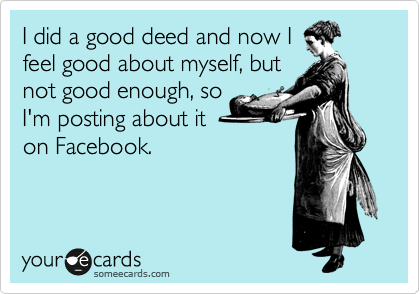Assignment 5
Assignment five revolved around good deeds, specifically five good deeds completed in one week. This assignment was meant to provoke thought about good behavior and how it would be altered if one was required to do good deeds daily. I learned how good behaviors influence the attitude of the self and the general emotional mood. Similarly, this experiment can be compared to one of the artifacts we were required to do. In the experiment, I had to act outside the norm and record other’s reactions, but this also had a negative effect on my mood, while the good deed experiment had a positive effect on my mood. This shows a direct comparison on how acting out of the norm for the individual influences both attitude and mood. This assignment was also personally relevant for me because of my affiliation with karma, as mentioned in the assignment. I try to keep myself in good standings in order to stay out of the negatives. This assignment really made me look at all the good deeds I do, and rethink why I do them.
Representative Visual Image:

This image represents my reaction to the prompt of assignment five, where it asked if we should make good deeds mandatory. I firmly believe that would belittle the good deed in the same fashion talking about your good deeds do when you crave attention. I believe good deeds should occur for the correct reason and not just to gather positive attention around the self.
Assignment Three
Assignment three revolved around the idea if anger is a logical or valid reason for racial hate and prejudice to be spewed out from an individual, in this case Michael Richard. Though there are many psychological disorders where extreme accounts of anger are possible, there is not a sturdy foundation to disprove that slurs are said without prejudice and discrimination. The assignment led me to revisit the past chapters reflecting around self-representation and image promotion. Celebrities want us to see them as good people with thoughts for equal rights and representation, thus they produce a self-representational image reflecting these good characteristics. However, these representational images can be broken in instances like Michael Richard’s. His “true colors” were shown and his deep-seeded hatred and prejudice were revealed, thus, breaking his previous representational image and people have changed their entire schemas and mindsets about him from this explosion of racially charged remarks. The assignment also connected with me personally through prejudice and discrimination. As a lesbian woman, the amount of times I heard the slur “faggot” growing up is astronomical. I have heard it in my own house, first not directed towards me and then later screamed in my face. My father has said that word, despite fighting for the equality this country stands on, and eventually kicked me out of the house because “no faggot will be a daughter of mine.” People place these masks on themselves like Richard and my father to make themselves seem like good people, but underneath have these prejudices waiting to be revealed.
Representational Visual Image:

This image relates to assignment three and my personal experience with prejudice and discrimination. I think it is also the perfect representation of how hatred is taught, and so is prejudice and discrimination.
Assignment Two
Assignment Two was meant to apply an in-depth analysis of the self, using terminology and concepts learned from chapter four. Chapter four was about the personal and social self; how we display ourselves and if there is a possible “true” self. The assignment relied on self-presentation and impression formation, our self-concept, and analyzing which pictures show us and reveal our “true” selves. Self-presentation refers to how we present, or display, ourselves to others in social situations, including online. Self-concept refers to how we think of ourselves, our social identity and the evaluation of our social identity.
The entire assignment reflected around the dissection of our social selves and our interpretation based around our self-presentation. Our self-presentation and concept are based upon our heuristics. We make ourselves fit in both our representative heuristic and availability heuristic. This is how we create our social self. Both of those heuristics are based on the world around us: media, friends, family, and culture. For example, as an art student I want to fit in the category of art students in my representative heuristic. However, the masks we wear in social situations are based off our availability heuristics; where we mold to fit in the best category to fit in for any given social situation.

I chose this image because it is the first self-portrait I have ever made. Painting myself was an experiment that displayed the physical awareness I have of both my self-concept and my self-presentation.
Assignment One
Assignment one was meant to apply an in-depth analysis of the types of heuristics through providing a definition and an original example for each heuristic. There are four main types of heuristics: availability heuristic, representative heuristic, status quo heuristic, and anchoring and adjustment heuristic. Each of these heuristics are used in daily situations and individuals are typically unaware during the use of heuristics. Yet, heuristics are not always positively used and are often to blame for prejudice and discrimination, as quoted in assignment one. They also provide falsehoods due to media inclusion, found in module four, where most media portray inaccurate representations leading to fear and inaccurately developed heuristics. In the assignment I learned the differences between heuristics and the exceptional reasons for why we should be aware of the instantaneous decisions being made. With awareness about heuristics, discrimination and prejudice could be halted, and the media’s neurological affect could be lessened.
What I learned from assignment one can also be applied to later chapters in the course. For example, in chapter three: impression formation deals with heuristics. In a job interview, you would dress to impress because formal entire and good hygiene fits into the representative heuristic of the interviewer. The interviewer is more likely to hire someone that fits within their representative heuristic for the job. In chapter four, the development of our social identity also relies on heuristics and the assessment of other’s heuristics. For example, we want friends that fit in our group and we judge people we meet through our representative heuristic. Likewise, we base our social identity with our availability heuristic, where we build a personality from the media available: movies, Instagram, Vine, etc.
What was learned from assignment one can be applied to daily life as well. For example, I do not fit in the typical group of lesbians in the average representative heuristic. In fact, I have been told on many occasions that I don’t “look gay” or that I am “too pretty to be a lesbian.” In reality, I am the epitome of a “gold-star” lesbian. I have no need or want to be with a man and plan on marrying a woman. However, I also use my representative heuristic like everyone else based off how a woman is dressed and think “she’s definitely a lesbian” without speaking to her or knowing a single detail about her. Despite now being aware of my heuristics, I still happen to do that without recognition of doing that.
Representative Visual Image:

Maloney, Jonathan. (2019, April 16) ‘Availability Heuristic’ [Cartoon]. Intelligent Speculation. Retrieved from: https://libguides.ioe.ac.uk/c.php?g=482478&p=3299606
I chose this image because it represents daily life, where an individual is using his availability to make a decision that the media has propagated. It shows how the media entrenches in daily life and how heuristics can be incorrect when making life altering decisions.